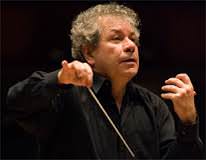Sometimes there’s reason to doubt why a symphony orchestra needs all those violins. Many of the labor disputes that are running around the country’s major professional ensembles, including a recent two-month lockout at the Atlanta Symphony Orchestra, turn on this kind of issue. The pressure to reduce a 96- to 100-man band to a number like 88 or 84 is growing intense and even understandable. That is, until you see and hear the Czech Philharmonic perform the New World Symphony by Antonin Dvorak.
There is not now, and never will be, any skimping by this European orchestra when presenting the signature work by the most famous composer to emerge from its country. The ultimate payoff on Friday night, when the Czech Philharmonic performed the New World at George Mason University’s Center for the Arts, came in the fourth and final movement when the violins and trumpets traded turns proclaiming the majestic theme that carries the piece to its conclusion.
You can hear this Dvorak theme a dozen times in recordings, but nothing compares with hearing live the equal force of the brass and strings in this passage when they’re both at full manpower. Or, even better, the sweeping countermelody that all 60 of the string instruments unanimously wrapped around the brass instruments’ turn at the main theme. Not for nothing does the Czech Philharmonic present its striking visual of eight string basses lined up against the back wall and perfectly centered against Conductor Jiri Belohlavek.

The stakes are high when the Czech Philharmonic tours the U.S. with arguably the most famous symphony this side of Beethoven. In doing so it’s essentially replicating Dvorak’s own adventure, who spent 2½ years in the U.S. during the 1890s and composed the New World Symphony – officially, the Symphony #9 in E minor – to highlight his time in America. Not only was Dvorak in the audience when the New York Philharmonic debuted the piece at Carnegie Hall in 1893, but he was the conductor when this very orchestra, the Czech Philharmonic, was subsequently founded and played the New World at its debut concert in Prague on January 4, 1896.
Filled with melodies inspired by the sequences of notes and scales that tend to find their way into folk music, the New World Symphony inspires audiences with themes reminiscent of “Swing Low, Sweet Chariot,” “Goin’ Home,” “Three Blind Mice” and other songs. The Czech Philharmonic’s program notes did a great job of unpacking certain myths about whether Dvorak was directly quoting songs he heard or it was the other way around – that various American songs originated in this symphony. The key point is that the folk flavor of Dvorak’s music didn’t start with the New World, as he regularly worked national and gypsy (or indigenous) musical modes from Central Europe into his large compositions. Local audiences can discover that for themselves when the Fairfax Symphony Orchestra performs Dvorak’s wonderfully tuneful Symphony #8 on this very same stage on Saturday, February 7, 2015.
Throughout the first three movements of the New World, Belohlavek (pronounced bell-oh-LAH-vetch) guided his orchestra to caress these folk themes by introducing them at very moderate dynamic levels to give them plenty of room to grow in size and scope as they transform into more typical “symphonic” material. That was a welcome contrast to other conductors who tend to barge into these themes as if the New World is just another big symphony from a contemporary of Dvorak’s like Brahms or Tchaikovsky.

Paired with the New World on this program was a different kind of contrasting work, the ultra-virtuoso Piano Concerto #2 by Franz Liszt with Jean-Yves Thibaudet at the keyboard. This concerto is not split into separate movements but rather six conjoined “sections” that largely alternate song-like piano themes with massive outpourings of notes that splatter and pound against orchestral colors.
Thibaudet, a bit of a rock star in the classical world who is known for his sartorial sense and his collaborations with everyone from Michael Tilson Thomas to Billy Joel, was best when he brought out interior melodies from within his part, particularly one that teamed with a beautiful solo countermelody line by principal cellist Vaclav Petr. Thibaudet was less effective in really teasing out main melodies on his top notes when there was so much filler to display below it. Thibaudet sits very close to the piano and the visual effect of his playing across the length of the keyboard was even more grasshopper-like than other Liszt virtuosos.
Just once I’d like the audience buzz after a Liszt concerto to be about the emotional effect of the music rather than the technical display. Thibaudet’s performance didn’t provide that, but his presence certainly helped sell tickets, and for largely filling George Mason’s big concert hall for this orchestra he deserves thanks.
It also gave the audience a chance to hear the Philharmonic’s opening piece, a less frequently performed three-movement work by early 20th century Czech composer Leos Janacek that’s based on a Russian story called Taras Bulba. Essentially a depiction of early defeat and subsequent survival in wartime, the piece employs a large variety of percussion effects to help “tell a story.” Dissonant themes in the first two movements are redeemed by an almost Hollywood-sounding final movement rendered very effectively by Maestro Belohlavek and his assembled troops. So were two brief and winning encores by other Czech composers.
Throughout the evening it was tremendously pleasing to watch Mr. Belohlavek conduct, which he did entirely from memory except for the concerto by the Hungarian Liszt. (My guess is that he has memorized every note ever written for an orchestra by a Czech composer.) Without being ostentatious in the slightest, Mr. Belohlavek’s motions are clean and economical when the music is straightforward and more demonstrative when complexities arise, with a distinct upward sweeping motion that he uses for cutting off the full orchestra.

The orchestra also demonstrated the benefit of participating in a current, welcome trend to place younger players at the head of sections rather than rely exclusively on seniority. Not only Mr. Petr on the cello but also Concertmaster (or lead violinist) Josef Spacek Jr. and principal violist Jaroslav Pondelicek shone brilliantly on their various “moments,” especially Mr. Spacek’s lovely tone in multiple solo violin lines during Taras Bulba. It was truly wonderful to watch these three young men set the standard for the veteran musicians surrounding them.
And call it a small thing but kudos to the entire ensemble of musicians for knowing how to take a bow. Each of the many instrumentalists who were singled out by Maestro Belohlavek to stand up after each piece before the full orchestra took the applause smiled and did a practiced half-bow. That’s a big improvement over the typical presentation after a major orchestral work where the musicians with key solo lines in the piece are called upon to rise and they just stand there looking like they wish the earth would open up and swallow them. Come on, this is showbiz! We can all learn from the Europeans how to do this right.
Running Time: Two hours, including one 15-minute intermission.
The Czech Philharmonic performed on Friday, November 14, 2014 at 8 p.m. at George Mason University’s Center for the Arts – 4373 Mason Pond Drive, in Fairfax, VA. For future events at The Center for the Arts, go to their calendar.
After performing this program at Carnegie Hall today, the Czech Philharmonic returns to Washington to perform the New World Symphony and other Czech music at the National Cathedral on Monday, November 17, 2014 at 7 p.m. in a 25th anniversary commemoration of the “Velvet Revolution” in the Czech Republic.
LINKS
Czech Philharmonic website.
Jean-Yves Thibaudet website.
https://youtu.be/2H3d2uOtEjY




